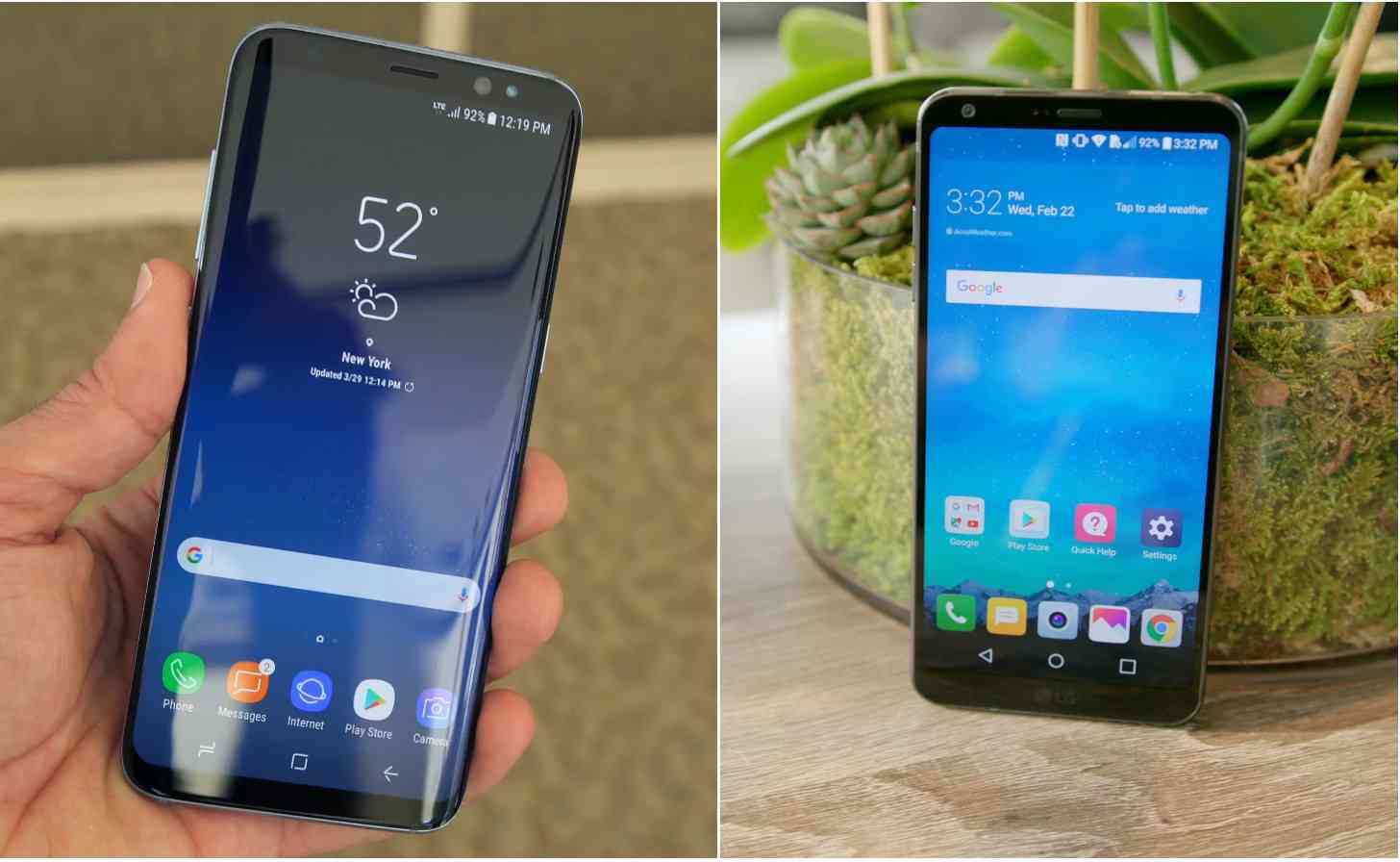
Bezel haters have a couple of good reasons to be excited now that the LG G6 and Samsung Galaxy S8 duo have been made official over the past month. Both phones are flagships of their respective manufacturers, and both feature one major design change set to take the smartphone industry by storm this year: shrinking bezels. Yet, despite this key design feature of both devices, there are several differences worth taking into consideration if you’re in the market for a new, nearly bezel-free device.
Let’s talk about the LG G6 first. Last year’s “modular type” LG G5 didn’t make the impact that LG was hoping it would, so the company is reverting to a more traditional style (i.e. no modules) this year. Although the company went back to a more familiar design, it still manages to stand out by making the G6 one of the first smartphones with such slim bezels available in the U.S.
The LG G6 features a 5.7-inch 1440 x 2880 resolution (~564 ppi) QHD+ display, giving the device an ~80% screen-to-body ratio. The display also features Dolby Vision HDR and an Always On Display. LG took a chance by using last year’s quad-core Snapdragon 821 processor, but was probably a better move than waiting until after Samsung released the Galaxy S8 to use the Snapdragon 835. There are 4GB of RAM, 32 or 64GB of internal storage with microSD support up to 256GB, dual 13-megapixel rear-facing cameras with f/1.8 and OIS, 5-megapixel front-facing camera, and a non-removable 3,300 mAh battery. Other features include USB-C fast charging, wireless charging, fingerprint reader on the back, integrated Google Assistant and IP68 rating.
On the contrary, Samsung ran with the success of the Galaxy S7 and made some subtle-yet-significant changes to its design in the Galaxy S8 and S8+. Changes include opting to only use edged displays, pushing out the bezels on each side, hiding the physical button underneath the display and moving the fingerprint sensor to the back.
The Galaxy S8 features a 5.8-inch (6.2-inch for Galaxy S8+) 1440 x 2960 resolution (~570 ppi, ~529 in S8+) Super AMOLED display, giving the device a ~83.6% and 84% screen-to-body ratio, respectively. Always On Display is also a feature of both devices. The Galaxy S8 duo are the first to feature Qualcomm’s latest octa-core Snapdragon 835 processor. Some variants of the S8 will use Samsung’s Exynos 8895 processor. Both devices have 4GB of RAM and feature 64GB of internal storage with microSD support up to 256GB. The pair uses a 12-megapixel rear-facing camera with f/1.7 and OIS and an 8-megapixel f/1.7 front-facing camera with HDR. The Galaxy S8 uses a non-removable 3,000 mAh battery, while the Galaxy S8+ features a 3,500 mAh battery. Other features include USB-C fast charging, wireless charging, integrated Bixby assistant (with dedicated physical Bixby button) and IP68 rating.
Pricing and promotions are another area where both attempt to reel in potential buyers. The G6 is set to be marginally cheaper than the S8 by a range of about $30-$100, depending on where you intend to shop, and each carrier has their own set of promotions going on for the upcoming release of the flagship. Most carriers in the U.S. will offer a free Google Home (normally $130) with the G6, and some carriers are offering even more on top of that.
Samsung, who has become well-known for its flagship launch promos at this point, also has no shortage of freebies that will come with the purchase of a new Galaxy S8 such as a Gear VR, controller, and Oculus gift pack. Those who pre-order the Galaxy S8 can also get a pair of AKG headphone and 256GB microSD card for an additional $99 (which I previously misunderstood as being free, which isn’t the case). Best Buy is offering an additional $100 on top of carrier-specific promotions as well.
On a personal level, I can say that my experience with the Galaxy S7 has helped me see Samsung in a more positive light. It’s a nice device, and I have no qualms with its performance, and I’m particularly fond of its camera. What I do have a problem with are its sloped edges, which has proved difficult when it comes to palm rejection and finding a good case that I feel confident isn’t compromised by its edges. However, that's the Galaxy S7; the S8 appears to have less dramatic sloped edges, and hopefully palm rejection has been improved upon.
The G6, on the other hand, doesn’t have sloped edges at all. However, the compromise here is that the screen is slightly smaller, but only by 0.1-inch. Some may also be put off by last year’s quad-core 821 processor compared to the S8’s octa-core 835 or Exynos 8895, but the average smartphone user probably wouldn’t notice.
Overall, both devices look solid. The idea of having a larger screen without a larger body seems like a great solution to the growing concern that smartphones are simply becoming too big, and both companies clearly put a lot of effort into these designs. The LG G6 will be first to hit shelves, beating the Galaxy S8 by at least a few weeks and giving LG a bit of a head start. However, given that Samsung’s Galaxy brand is one of the most popular in the industry, it will be interesting to see how the LG G6 manages to hold up against the S8 over time, especially when you consider how closely the two compete with each other.
Readers, what are your thoughts on the S8 versus the G6? Let us know your thoughts in the comments below!